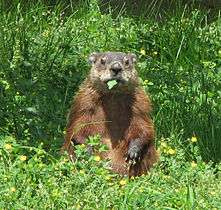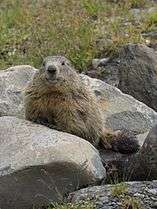Marmot
| Marmot Temporal range: Late Miocene–Recent | |
|---|---|
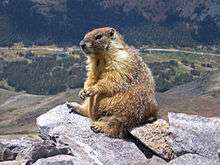 | |
| Yellow-bellied marmot | |
| Scientific classification | |
| Kingdom: | Animalia |
| Phylum: | Chordata |
| Class: | Mammalia |
| Order: | Rodentia |
| Family: | Sciuridae |
| Tribe: | Marmotini |
| Genus: | Marmota Blumenbach, 1779 |
| Species | |
|
15, see text | |
Marmots are large squirrels in the genus Marmota, of which there are 15 species. Some species live in mountainous areas, such as the Alps, northern Apennines, Carpathians, Tatras, and Pyrenees in Europe and northwestern Asia; the Rocky Mountains, Black Hills, the Cascade and Pacific Ranges, and the Sierra Nevada in North America; and the Deosai Plateau in Pakistan and Ladakh in India. Other species prefer rough grassland and can be found widely across North America and the Eurasian Steppe. The similarly-sized but more social prairie dog is not classified in the genus Marmota but in the related genus Cynomys.
Marmots typically live in burrows (often within rockpiles, particularly in the case of the yellow-bellied marmot), and hibernate there through the winter. Most marmots are highly social and use loud whistles to communicate with one another, especially when alarmed.
Marmots mainly eat greens and many types of grasses, berries, lichens, mosses, roots, and flowers.
Subgenera and species
The following is a list of all Marmota species recognized by Thorington and Hoffman[1] plus the recently defined M. kastschenkoi.[2] They divide marmots into two subgenera.
- Genus Marmota – marmots
- Subgenus Marmota
- Alpine marmot, M. marmota found only in Europe in the Alps, northern Apennine Mountains in Italy, Carpathian Mountains, Tatra Mountains, and reintroduced in the Pyrenees
- Forest-steppe marmot, M. kastschenkoi found in south Russia[2]
- Gray marmot or Altai marmot, M. baibacina found in Siberia
- Bobak marmot, M. bobak found from central Europe to central Asia
- Alaska marmot, Brower's marmot, or Brooks Range marmot, M. broweri found in Alaska
- Black-capped marmot, M. camtschatica found in eastern Siberia
- Long-tailed marmot, golden marmot, or red marmot, M. caudata found in central Asia
- Himalayan marmot or Tibetan snow pig, M. himalayana found in the Himalayas
- Menzbier's marmot, M. menzbieri found in central Asia
- Groundhog, woodchuck, or whistlepig, M. monax found in most of North America
- Tarbagan marmot, Mongolian marmot, or tarvaga, M. sibirica found in Siberia
- Subgenus Petromarmota
- Hoary marmot, M. caligata found in northwestern North America (Canada and Alaska)
- Yellow-bellied marmot, M. flaviventris found in southwestern Canada and western United States
- Olympic marmot, M. olympus endemic to the Olympic Peninsula, Washington, United States
- Vancouver Island marmot, M. vancouverensis endemic to Vancouver Island, British Columbia, Canada
- Subgenus Marmota
Additionally, four extinct species of marmot are recognized from the fossil record:
- †Marmota arizonae, Arizona, U.S.
- †Marmota minor, Nevada, U.S.
- †Marmota robusta, China
- †Marmota vestus, Nebraska, U.S.
History and etymology
Marmots have been known since antiquity. Research by the French ethnologist Michel Peissel claimed the story of "gold-digging ants" reported by the Ancient Greek historian Herodotus, who lived in the fifth century BCE, was founded on the golden Himalayan marmot of the Deosai Plateau and the habit of local tribes such as the Brokpa to collect the gold dust excavated from their burrows.[3]
The etymology of the term "marmot" is uncertain. It may have arisen from the Gallo-Romance prefix marm-, meaning to mumble or murmur (an example of onomatopoeia). Another possible origin is post-classical Latin, mus montanus, meaning "mountain mouse".[4]
Beginning in 2010, Alaska celebrates February 2 as "Marmot Day", a holiday intended to observe the prevalence of marmots in that state and take the place of Groundhog Day.[5]
Examples of species
-
%2C_Yosemite_NP_-_Diliff.jpg)
Yellow-bellied marmot (Marmota flaviventris,Tuolumne Meadows, Yosemite National Park
-
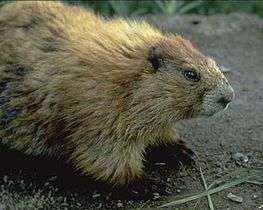
Olympic marmot (Marmota olympus)
-

Hoary marmot (Marmota caligata), Mount Rainier National Park
-
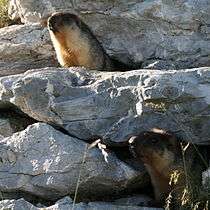
Black-capped marmot (Marmota camtschatica)
-
Long-tailed marmot (Marmota caudata), Pakistan
-
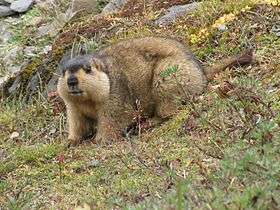
Himalayan marmot (Marmota himalayanus), Bhutan
-

Gray marmot (Marmota baibacina), Altai Mountains, Kazakhstan
-
Tarbagan marmot (Marmota sibirica), Russia and Mongolia
-
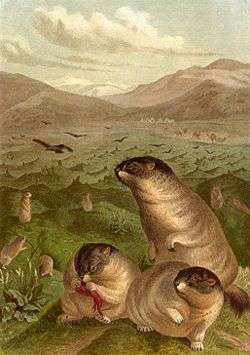
Drawing of bobak marmot (Marmota bobak)
References
- ↑ Thorington, R. W., Jr., and R. S. Hoffman. (2005). "Family Sciuridae". Mammal Species of the World: A Taxonomic and Geographic Reference, pp. 754–818. D. E. Wilson and D. M. Reeder, eds. Johns Hopkins University Press, Baltimore.
- 1 2 Brandler, OV (2003). "On species status of the forest-steppe marmot Marmota kastschenkoi (Rodentia, Marmotinae)". Zoologičeskij žurnal (in Russian). 82 (12): 1498–1505.
- ↑ Peissel, Michel. "The Ants' Gold: The Discovery of the Greek El Dorado in the Himalayas". Collins, 1984. ISBN 978-0-00-272514-9.
- ↑ "Marmot". Oxford English Dictionary (3rd ed.). Oxford University Press. September 2005. (Subscription or UK public library membership required.)
- ↑ The Associated Press. "Alaska to Celebrate its First Marmot Day", Fairbanks Daily News-Miner. Feb. 1, 2010. Accessed Feb. 1, 2010.
External links
| Wikimedia Commons has media related to Marmot. |
